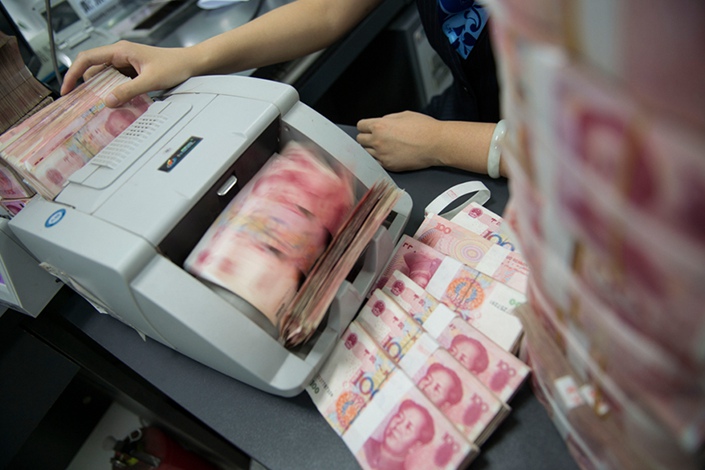Central Bank Faces Tough Balancing Act After Reserve Cut

*Much of the liquidity released by a targeted cut to most banks’ reserve requirement ratios will support debt-for-equity swaps or be used for loans to small businesses
*However there are concerns that the swaps could impair banks’ capital adequacy if they write off a large amount of bad loans in return for little-valued equity holdings
(Beijing) — The targeted cut to most banks’ reserve requirement ratios (RRRs), which was announced on Sunday, aims to shore up the economy against headwinds while maintaining a close eye on financial risks, but the central bank will struggle to balance competing priorities, analysts said.
The People’s Bank of China (PBOC) announced Sunday it will cut for some lenders the amount of cash set aside as reserves by 50 basis points from July 5, releasing a total of 700 billion yuan ($107.6 billion) in funding. The RRR is currently 16% for large banks and 14% for smaller banks.
Around 500 billion yuan will be used by the five state-owned banks and the 12 national joint-stock commercial lenders to support debt-for-equity swaps, an unnamed official with the PBOC said in a statement. Another 200 billion yuan, intended for loans to small businesses, will be released to small and midsize lenders.
The only banks excluded from the cut are county-level rural commercial banks and rural credit unions, according to Nomura International (Hong Kong) Ltd., an investment bank.
This cut, the third of 2018, was widely expected after a State Council meeting on Wednesday said monetary policy tools like targeted RRR cuts would be used to help smaller firms access financing, among other things. However, the amount of liquidity released exceeded market expectations, according to analysis from CEBM. The last RRR cut on April 25 released a net total of 400 billion yuan, which was also intended to be used to help small businesses.
Signs of slowdown
“This latest move reflects the PBOC’s efforts to seek a balance between economic stability and deleveraging,” Zhu Chaoping, global market strategist at J.P. Morgan Asset Management, said in a note.
While the cut signals moderate monetary easing, the guidance given by the central bank for using the released funds reflects its concerns that the liquidity could flow into property and financial markets, instead of the real economy. “This is a very challenging job for the PBOC,” he said.
China’s economic growth showed signs of a slowdown in May as expansion in fixed-asset investment, industrial output and retail sales all trailed analysts’ estimates, raising expectations of moderate monetary easing. A looming trade war is also dampening investor confidence — tariffs threatened by both U.S. and China are due to come into effect from July 6, the day after the RRR cut will go into effect. Stock markets plunged last week on news that the U.S. will impose tariffs of 25% on $50 billion worth of Chinese imports.
Targeted cuts
The bulk of the new funding released is intended to be used to support debt-for-equity swaps, an important part of Beijing’s deleveraging agenda. Through these swaps, bank lenders are transformed into equity investors in the troubled businesses that they have financed.
Using RRR cuts to support debt-for-equity swaps shows that “policymakers still see risk prevention as the top priority,” according to Ming Ming, chief fixed-income analyst at Citic Securities. These swaps are proceeding more slowly than was hoped — as of the end of 2017, 102 companies had signed debt-to-equity swap agreements, but only 20 had implemented them, according to official statistics.
However, debt-for-equity swaps could impair banks’ capital adequacy if they write off a large amount of bad loans in return for little-valued equity holdings, according to analysts from Nomura.
The remaining liquidity released is intended to help increase small and micro-sized companies’ access to financing, a long-running government priority. Thirteen companies defaulted on 14.2 billion yuan in corporate debt from January to early June, already more than half the value of defaults over all of 2017.
“Despite today’s RRR cut, we believe the Chinese economy is yet to bottom out, and the situation could get worse before getting better,” Nomura analysts said on Sunday.
Many analysts expect more RRR cuts in the second half of the year. “With the strong internal and external headwinds in 2H, we expect Beijing to introduce more easing measures in coming months,” they said. “More specifically, we expect at least another RRR cut on a scale of 100bp (base points) before year-end.”
Targeted RRR cuts may not be sufficient to hedge against the sharp contraction of credit in the economy and a rapid downturn, according to a note from Ping An Securities analysts. If downward pressure on the economy increases further, the central bank may still have to use more general easing, the note said.
Contact reporter Ke Baili (bailike@caixin.com)

- 1China Sets 2026 Economic Priorities With Demand Revival at the Core
- 2In Depth: China Bad-Debt Managers’ Bet on Bank Stocks Could Backfire
- 3Beijing Moves to Rein in Steel Exports With New Licensing Rule
- 4China Ramps Up Effort to Offload Vast Supply of Unsold Homes
- 5China’s Elite-Focused Schools Are Failing Most Students, Top Educators Say
- 1Power To The People: Pintec Serves A Booming Consumer Class
- 2Largest hotel group in Europe accepts UnionPay
- 3UnionPay mobile QuickPass debuts in Hong Kong
- 4UnionPay International launches premium catering privilege U Dining Collection
- 5UnionPay International’s U Plan has covered over 1600 stores overseas




